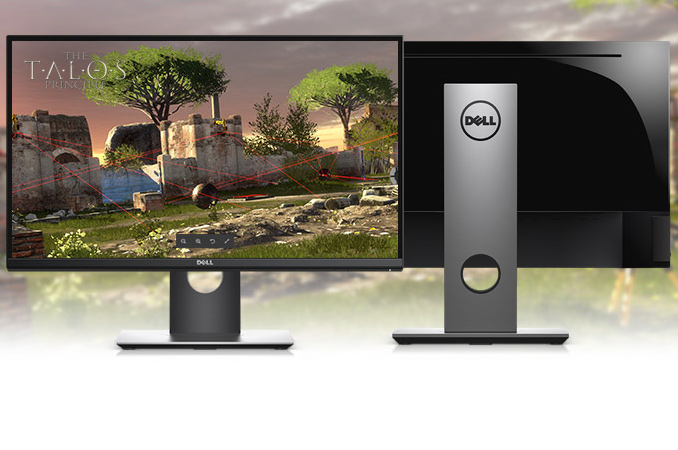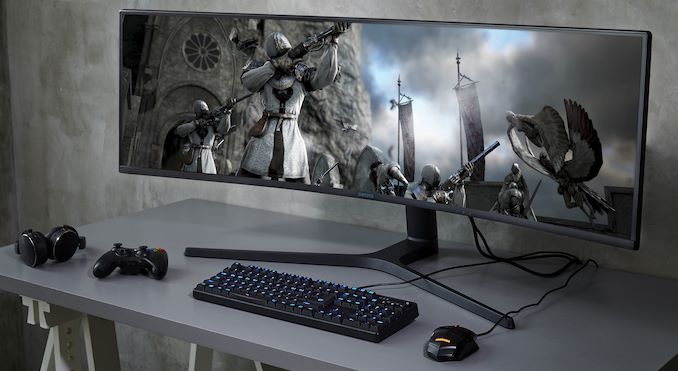IDC PC Monitor Trends: IPS and 21.5-Inch Most Popular, Curved Displays Get Traction
by Anton Shilov on October 3, 2019 5:00 PM EST
Sales of large displays and/or gaming displays have been increasing in the past few years, but recently monitor manufacturers have also rolled-out oversized displays and curved LCDs for their clientele. But while the market install base of such advanced displays is growing, the most popular monitors still measure 21.5 inches, according to analysts from IDC. Meanwhile, IPS LCD panels now dominate the market, leaving TN and VA behind.
IDC market researchers expect 122 million PC monitors to ship in 2019, down 1% from the previous year. In Q2, sales of PC displays totaled around 30 million units, driven by migration of commercial desktops to Windows 10 yet offset by manufacturers’ focus on premium gaming and curved LCDs and their emphasis shift away from volumes to focus on higher ASP growth.
Based on data from IDC, displays featuring a 21.5-inch diagonal are still the most popular, and analysts expect that populatity to stick until 2023, where it sees the 23.8-inch market becoming top. Whether this popularity stems from the screen size or the price of the display is another matter entirely. As larger displays are manufactured in larger quantities, in a commodity market, eventually pricing of the larger displays is reduced.
Nonetheless, sales of curved monitors (which mostly belong to the premium segment) grew 44.7% year-over-year in the second quarter. It is believed (by some other analysts) that half of all curved displays are designed for gamers, which means that these displays offer advanced features and might command a significant premium because of that market.
It is also noteworthy that IDC reports that IPS-based LCDs now account for about 50% of the market, trailed by TN and VA panels, which inidicates demand for higher-quality displays is growing. The one market that TN panels still held was for fast refresh rates, but so-called ‘Fast IPS’ panels have entered the market which have refresh rates of up to 240 Hz while offering great viewing angles and saturated colors, so it remains to be seen how the panel market develops in the coming years.
As far as monitor manufacturers are concerned, Dell retained its No. 1 position in Q2 with a 21.4% market share followed by HP with a 15.2% share. TPV, the only Top 5 display maker that managed to significantly boost its shipments in the second quarter, commanded 14.4% of the market trailed by Lenovo with a 10% share as well as LG with a 8.2% share.
| Top 5 PC Monitor Makers Q2 2019, IDC |
|||||||
| Q2 2019 | Q2 2018 | Q2 2018-> Q2 2019 |
|||||
| Sales | Share | Sales | Share | Growth | |||
| Dell | 6.4 million | 21.4% | 6.4 million | 20.7% | 1.1% | ||
| HP | 4.6 million | 15.2% | 4.7 million | 15.2% | -1.9% | ||
| TPV | 4.3 million | 14.4% | 4.0 million | 13.0% | 8.9% | ||
| Lenovo | 3.0 million | 10.0% | 3.2 million | 10.4% | -5.8% | ||
| LG | 2.5 million | 8.2% | 2.5 million | 8.3% | -3.3% | ||
| Others | 9.2 million | 30.7% | 10.0 million | 32.4% | -7.3% | ||
| Total | 30.1 million | 100% | 30.7 million | 100.0% | -2.2% | ||
This information is derived from recent IDC press releases. IDC offers the full report.
Related Reading
- Sales of High Refresh Gaming Displays Skyrocketing, Curved Gaming LCDs Prevail
- HP Launches Their S430c 43.4-Inch Ultrawide Curved Display
- Need for Speed: The LG UltraGear (27GN750) 240 Hz IPS Monitor with G-Sync
- Lenovo’s ThinkVision S28u-10: A 4K Business Display
- ASUS ProArt PA32UCG: The Ultimate Mini LED 4K 120 Hz Monitor with HDR 1600
Source: IDC











29 Comments
View All Comments
DanNeely - Thursday, October 3, 2019 - link
For anyone wondering who TVP is, they're a Chinese company that sells under the AOC and Envision brands.StevoLincolnite - Thursday, October 3, 2019 - link
Curved... Me: Hiss.yetanotherhuman - Friday, October 4, 2019 - link
Don't knock a 38" 3840x1600 curved screen until you've tried it. You'll understand. It's great.dullard - Friday, October 4, 2019 - link
Curved screens are great. But ultrawide resolutions such as 3840x1600 suck. Endless vertical scrolling if you are doing productivity or social media. No ability to see enemies above or below if you are gaming. Give me my vertical portion of the screen back! I can't stand the current trend of paying more for a shorter screen.Black Obsidian - Friday, October 4, 2019 - link
Ultrawide screens are just 16:9 monitors with an extra ~30% width added on. So they're no worse for gaming than their 16:9 progenitors, and the extra horizontal real estate is useful for productivity; a 1440p ultrawide can effectively replace two 1080p 16:9s.Now, if you're still fighting the 16:9 vs 16:10 war, my heart goes out to you valiant brother/sister, but we lost that conflict nearly a decade ago. 21:9 may not restore our former vertical glory, but nor is it taking away what we have left.
dullard - Friday, October 4, 2019 - link
You drank the Kool Aid. In reality, ultrawide screens are just 16:9 monitors with 24% of the top chopped off.That 38" monitor (34.9" wide by 15.0" tall) could have been a 40" monitor (34.9" wide by 19.6" tall). But no, we lost the top 4.7" of screen space and have to pay more money for the privilege of calling this shortened monitor "wide". It isn't like we are running out of physical room above our monitors either. Most of that is just wasted air.
I know I'm fighting a losing battle. I will fight it to the bitter end though.
dullard - Friday, October 4, 2019 - link
We could always just have a "wide" mode where 4.7" of screen space isn't calculated or displayed for those who like losing this view.stephenbrooks - Friday, October 4, 2019 - link
You can find some pretty good 4K TVs in the 40-50" range that would give you what you want, except curvature.I debate how much curvature helps with gaming exactly. In theory it would actually distort the perspective unless the graphics driver corrected it. Of course you can set the game so that the vertical FOV is the same as a normal screen not the horizontal FOV.
Beaver M. - Saturday, October 5, 2019 - link
Depends on how the developers did the programming.Some add those 30% to the sides, others actually stretch the 16:9 viewfield to a bigger picture, so you will actually have a disadvantage with 21:9.
Gasaraki88 - Friday, October 4, 2019 - link
What? You are contradicting yourself. More vertical resolution means LESS scrolling..."no ability to see enemies above or below you..." -Once again more vertical resolution will let you see MORE.
"can't stand the current trend of paying more for a shorter screen." - 1600 vertical is more vertical space than 1280x1024, 1920x1080, 1920x1200, 2480x1440, and 3440x1440, so that more than 99% of monitors out there.